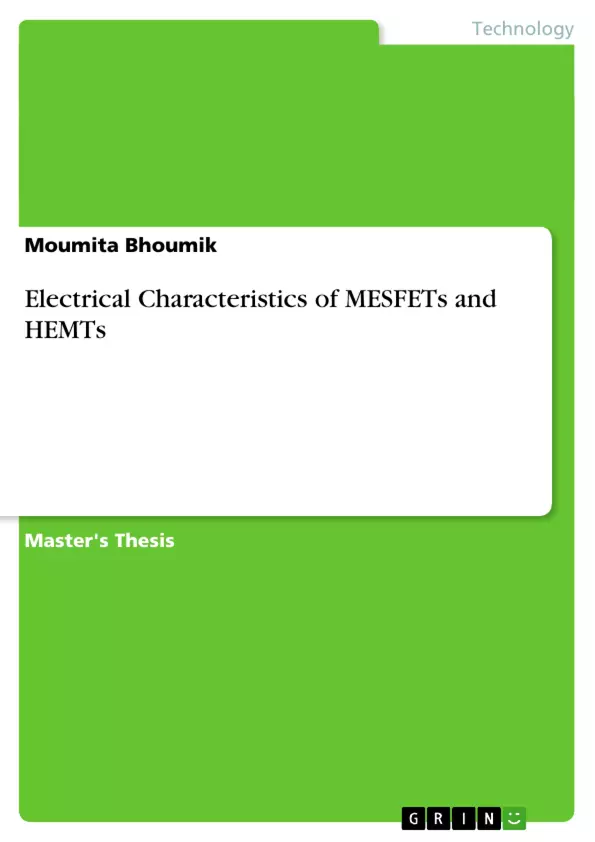Advanced developments that were made recently in the field of Silicon (Si) semiconductor technology have allowed it to approach the theoretical limits of the Si material. However there are latest power device requirements for many applications that cannot be handled by the present Si-based power devices. These requirements include such as higher blocking voltages, switching frequencies, efficiency, and reliability. And hence, new semiconductor materials for power device applications are needed to overcome these limitations.
For high power requirements, wide bandgap semiconductors like Silicon Carbide (SiC) and Gallium Nitride (GaN) and Gallium Arsenide (GaAs), which are having superior electrical properties, are likely to replace Si in the near future. This Study thesis compares the electrical characteristics of wide-bandgap semiconductors with respect to Silicon (Si) to verify their superior utility for power applications and predicts the future of power device semiconductor materials.
This thesis also includes the study that has been performed regarding the electrical characteristics of high frequency semiconductor devices in terms of I-V characteristics and Noise Power Spectral Density (PSD) Analysis with respect to drain current fluctuation in the semiconductor devices. The semiconductor devices that are used for this particular thesis are – Metal Effect Semiconductor Field Effect Transistors (MESFETs) and High Electron Mobility Transistors (HEMTs).
Inhaltsverzeichnis (Table of Contents)
- Chapter-1 Introduction
- Chapter-2 Semiconductors
- 2.1 Brief Introduction to Semiconductors
- 2.2 Defects in Semiconductor Crystals
- 2.3 Need for Wide Bandgap Materials
- Chapter-3 Study of Metal Effect Semiconductor Field Effect Transistor (MESFET)
- 3.1 Brief Introduction to MESFET
- 3.2 Theoretical Model of I-V Characteristics of MESFET
- 3.3 Material Selection for Substrates in MESFET
- 3.3.1. Advantages of Silicon Carbide (SiC) over Silicon (Si)
- 3.3.2. Advantages of Gallium Arsenide (GaAs) over Silicon (Si)
- 3.3.3. Applications and Benefits of SiC as Substrate
- 3.4. Comparative Study Analysis on MESFETs Using Different Substrates
- 3.4.1. I-V Characteristics of MESFET using Si, SiC & GaAs Substrates
- 3.4.2. I-V Characteristics of MESFET using 3C, 4H & 6H SiC Substrates
- Chapter-4 Study of High Electron Mobility Transistor (HEMT)
- 4.1 Brief Introduction to HEMT
- 4.2 Material Selection for Substrates in HEMT
- 4.2.1. GaAs HEMT
- 4.2.2. GaN HEMT
- 4.3 Theoretical Model of I-V Characteristics of HEMT
- 4.4. Study Analysis on GaAs & GaN with respect to SiC HEMTs
- 4.4.1. I-V Characteristics of SiC -HEMT
- 4.4.2. I-V Characteristics of GaAs -HEMT
- 4.4.3. I-V Characteristics of GaN HEMT
- Chapter-5 Noise Analysis on High Frequency Devices-MESFET & HEMT
- 5.1 Noise in Semiconductor Devices
- 5.2 Low Frequency Noise Analysis
- 5.2.1. Flicker (1/f) Noise
- 5.2.2. Generation-Recombination (G-R) Noise
- 5.3 Noise Power Spectral Density Analysis on MESFET
Zielsetzung und Themenschwerpunkte (Objectives and Key Themes)
This thesis aims to analyze and compare the electrical characteristics of wide-bandgap semiconductors, such as Silicon Carbide (SiC), Gallium Nitride (GaN), and Gallium Arsenide (GaAs), with Silicon (Si) for power applications. The study investigates the potential of these materials to overcome the limitations of silicon-based devices in meeting the increasing demands for higher blocking voltages, switching frequencies, efficiency, and reliability. The study also analyzes the I-V characteristics and Noise Power Spectral Density (PSD) of high-frequency semiconductor devices like Metal Effect Semiconductor Field Effect Transistors (MESFETs) and High Electron Mobility Transistors (HEMTs).- Electrical characteristics of wide-bandgap semiconductors (SiC, GaN, GaAs) compared to Silicon (Si)
- Superior electrical properties of wide-bandgap semiconductors for power applications
- Analysis of I-V characteristics and Noise Power Spectral Density (PSD) of MESFETs and HEMTs
- Comparison of the electrical characteristics of MESFETs and HEMTs with different substrates (Si, SiC, GaAs, 3C, 4H, 6H SiC)
- Study of low frequency noise (flicker and generation-recombination noise) in semiconductor devices
Zusammenfassung der Kapitel (Chapter Summaries)
- Chapter 1: Introduction This chapter provides a general overview of the thesis, highlighting the increasing need for new materials in power device applications due to the limitations of silicon-based devices.
- Chapter 2: Semiconductors This chapter provides a brief introduction to semiconductors, discusses defects in semiconductor crystals, and emphasizes the importance of wide bandgap materials for power device applications.
- Chapter 3: Study of Metal Effect Semiconductor Field Effect Transistor (MESFET) This chapter focuses on the MESFET device. It delves into its theoretical model, analyzes the selection of suitable substrates, and compares the I-V characteristics of MESFETs using different substrates like Si, SiC, and GaAs.
- Chapter 4: Study of High Electron Mobility Transistor (HEMT) This chapter examines the HEMT device, exploring its theoretical model and analyzing the choice of substrates, including GaAs HEMT and GaN HEMT. It further compares the I-V characteristics of SiC, GaAs, and GaN HEMTs.
Schlüsselwörter (Keywords)
The key terms and concepts explored in this thesis revolve around the electrical characteristics of different semiconductor materials, especially the comparison of wide-bandgap semiconductors like SiC, GaN, and GaAs with conventional silicon (Si). The study focuses on the superior properties of these materials for power applications, examining their potential to overcome the limitations of silicon-based devices. The thesis also delves into the analysis of I-V characteristics and noise characteristics (PSD) of high-frequency semiconductor devices, particularly MESFETs and HEMTs, exploring the influence of different substrates and the impact of noise phenomena such as flicker and generation-recombination noise.- Quote paper
- Moumita Bhoumik (Author), 2012, Electrical Characteristics of MESFETs and HEMTs, Munich, GRIN Verlag, https://www.grin.com/document/262118



